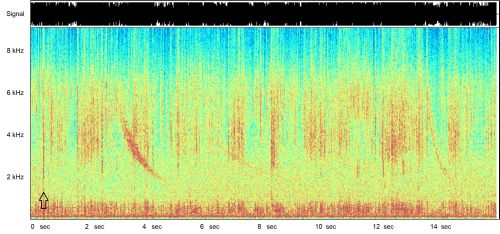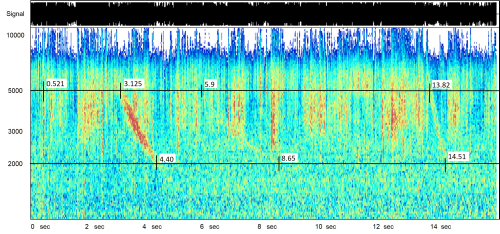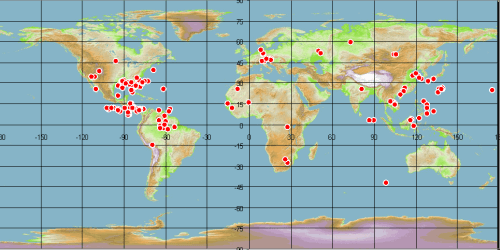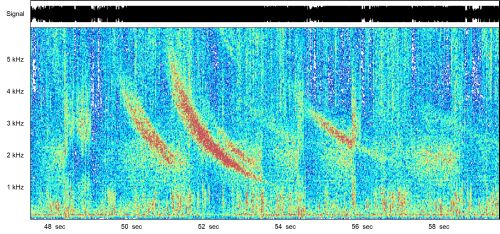Click on blue-rimmed images to enlarge.
Whistlers are the most spectacular of the natural radio emissions that are produced
by lightning. Under certain conditions in the ionosphere the radio pulse from the lightning
can partially penetrate and cross the ionosphere to enter the Earth magnetosphere. In this
low density plasma the radio waves can only propagate by following the field lines of
the Earth magnetic field. Because these emerge in one hemisphere and curve out up to
distances of 3 Earth radii, the waves traverse a long path through space
and come down only in the other hemisphere. Here they may cross the ionosphere and can be
received again. As they had to travel over a long path through the plasma, they are
heavily subject to dispersion: the lowest frequencies arrive a few seconds after the
highest frequencies. The initial 'click' is drawn out into a majestically sweeping
down in frequency, which sounds like 'piouuu' or a more hissy 'shpiouu': a whistler.

Note that because the radio waves cannot but follow the magnetic field lines, whistler
waves always travel north/south. Hence thunderstorms in Asia never make whistlers in
Europe.
When the whistler wave comes down to the ionosphere, only part of its energy can cross
the ionosphere and become audible as a one hop whistler. The other part is reflected back
to the magnetosphere and travels back to the other hemisphere. There again, one part penetrates
the ionosphere and is audible as a two hop whistler in the hemisphere from whence it came,
but the other part is reflected ... and so on ... Under certain conditions a whistler wave
can go back and forth several or many times between the hemispheres. This is called an
Echo Train.
To hear whistlers depends on several factors: first of all at the other end of the magnetic
field line that goes into space from the receiver's site there should be a thunderstorm
to furnish the lightnings. At both ends of the magnetic field line the ionosphere must be
in a condition to let the whistler wave pass through. Finally the conditions along the
magnetic field line must be favourable for the wave to propagate.
All these conditions are not met all the time. Thus, one needs a bit of patience to
hear whistlers. The best way is to listen as much as possible, and in a regular way.
When I am on the beach, I try to listen in once per hour, for about a minute. If I hear
nothing but spherics, I switch off again, but if I hear a swishing sound, I start recording.
You never know what might happen next!
Three Whistlers from Two Hemispheres
On 24 aug 2016 at CEST 20:13 the recording shows three whistlers:
The first is fairly strong and occurs 2.5 sec after a strong spheric (marked by
an arrow) which must be the source lightning. This means that it is a
two-hop whistler starting somewhere in Europe. After another 2.5 sec a fainter and
longer whistler follows, obviously the 4-hop echo. Then, at 14 sec,
a short whistler arrives. It is composed of two pure-tone whistlers.

listen to the sound file
For the analysis it is more convenient to use a logarithmic frequency
scale, as the whistlers will follow nearly straight lines:

The numbers at the marks are the times in seconds after the start of the
recording. They show:
- The time between the lightning spheric and the first whistler is
3.1-0.52 = 2.6 sec at 5 kHz; the time between first and second whistler
is nearly the same: 5.9-3.1 = 2.8 sec.
At 2 kHz the times are: 3.9 and 4.2 sec, which also agree - keeping in
mind the difficulty of measuring the weak second whistler.
- The duration in which the frequency falls from 5 to 2 kHz is
4.4-3.1 = 1.2 sec for the first whistler, and 2.75 sec for the second
one (more than twice as long).
- The duration of the third whistler is only 0.69 sec, just one half of
the time for the first whistler. Hence the third whistler made one
hop only ... it had its origin in southern Africa.
There are several national and international networks of receiving stations that listen
for spherics. Using the time delays measured by several stations, one can triangulate the
location of the lightning that caused a spheric. Fortunately, the
World Wide Lightning Location Network was so kind to provide
me with the data of the strong lightnings they had picked up during the 60 seconds of my
observations. On a map of these lightning locations one sees strong activity in Europe, but
also two lightning strikes in southern Africa. This accounts well for the recorded three whistlers!

The "Attack of the Martians" Echo Train
It seems that August 24th is my lucky day: in 2006 many whistlers were heard and
recorded on that day. The most spectacular series was at CEST 18:21, it sounded as if the Earth
was being invaded by the Martians:

listen to the sound file
Here is a zoom of the groups with the loudest whistler:

| Top of the Page
| Back to the MainPage
| to my JavaScript Tools
| to my Java Applets
| to my HomePage
|
last update: Apr 2018 J.Köppen





